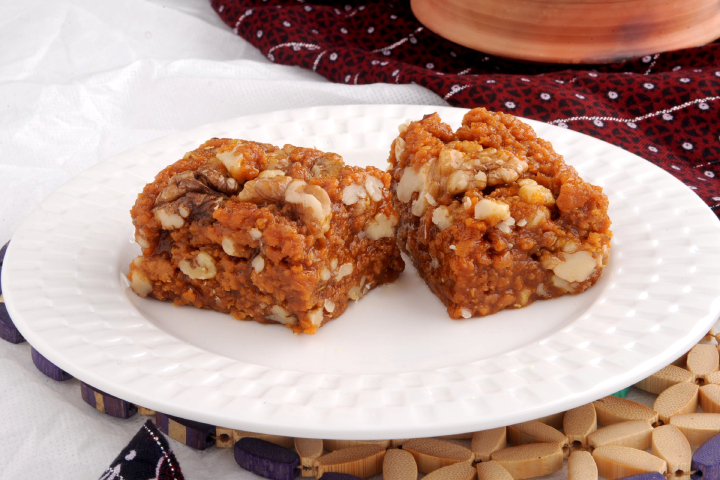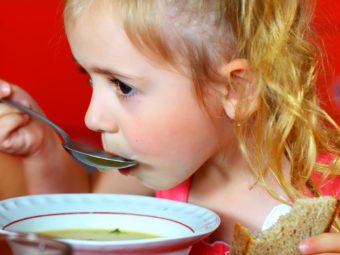
Image: Shutterstock
Walnuts are super healthy nuts that come with excellent health benefits. Hence most parents are keen to include walnuts for kids in chopped, finely ground, or other forms. They are great sources of healthy fats, fiber, and other essential nutrients and are also known to help manage a child’s blood pressure and digestion. A type of super-food, walnuts offer children an energy boost (11). Because of these and several other amazing benefits, these nuts add a lot of nutritional value and healthiness when included in your child’s meal plan. Keep reading to discover astonishing facts, health benefits, and more about walnuts.
Walnut Benefits For Kids – An Overview
Most pediatricians say that introducing allergens like tree nuts to babies before the age of one is not a good idea. Here are some important nutritional values of walnuts and the benefits as well.
Nutrient Value Of Walnuts
Walnuts boast of an amazing array of nutrients. Some special components include.
1. Omega-3 fatty acids:
Image: Shutterstock
Walnuts are rich in omega-3 fatty acids. Omega-3s are highly essential, as they help your kid maintain a normal blood pressure. Moreover, the nuts also help reduce your kid’s cholesterol level, reduce inflammation and keep his heart healthy (1). One of the most important walnut benefits for kids. A global study by the British Nutrition Foundation on adults revealed that consuming walnuts at least once a week was linked to a remarkable 17% reduction in the risk of stroke.
2. Magnesium:
Walnuts contain high amounts of magnesium. The mineral is vital for your kid as a low level of magnesium can increase the risk of him contracting Type 2 Diabetes (2).
3. Vitamins:
Image: Shutterstock
Walnuts are rich sources of Vitamin B1 and B6. These vitamins are essential for brain tissue development and promoting your nerve health (3).
4. Fats:
Walnuts are good in the healthy fat, polyunsaturated fat (PUFA) and also contain monounsaturated fats (MUFAs) (4). These fats help lower your kid’s LDL or bad cholesterol levels and reduce the risk of heart disease later on in his life.
Benefits Of Walnuts For Kids
Walnuts contain high amounts of essential nutrients. Some of their health benefits include:
1. Improves Memory:
Walnuts can be considered brain food for your child. They improve brain power by increasing memory and boosting brain cell activity (5).
2. For Hair:
Image: Shutterstock
Walnuts play a major role in keeping your child’s hair lustrous and shiny, as they contain high amounts of biotin (6).
3. Strong Antioxidant Properties:
Walnuts exhibit strong antioxidant properties and help your kid’s body get rid of toxic substances and free radicals.
Walnuts Facts And Information
Image: Shutterstock
Here some interesting information and facts about walnuts to teach your kids:
- Walnuts are the oldest known tree food.
- Walnuts are a regular ingredient in many varieties of ice cream and chocolates, which is why they are known as Persian walnuts. Black and White walnuts originate from North America.
- Walnuts hail from a family of Brazil nuts, Cashew nuts, Hazelnuts, Pistachios, Pecans and Pine nuts. The nuts originated in India and the Caspian Sea region.
- Today, China is the largest producer of Walnuts in the world.
- There are about 30 varieties of commercially produced walnuts.
- A common culinary use of walnuts in the 17th-19th centuries was in salads, something we do even today.
 Trivia
TriviaRecipes Using Walnuts For Kids
Walnuts are one of the most nutritious snacks for your kids. Find below two easy-to-make walnut recipes that can effortlessly incorporate the goodness of walnuts into your kid’s diet.
1. Candied Walnut Recipe
If your kids seem to be put off by the weird shape or you can’t get them to eat walnuts, consider making some candied walnuts for them. Follow the recipe below and let your little one have fun relishing the tasty, crunchy goodness of these nuts.
You Will Need:
- Sugar (around ¼ cup)
- Honey (approx. one tablespoon)
- Water (around 2 cups)
- Salt to taste
- Walnut halves (around 2/3rd cup)
- Aluminum foil
- Baking sheet
How To:
- Line a baking sheet with aluminum foil.
- Mix honey, water, salt, and sugar in a bowl.
- Pour the mixture out into a pan. Start cooking over medium or high heat for around three to four minutes with occasional stirring.
- Add walnuts to the pan and reduce the heat
- Wait until the mixture turns golden brown.
- Proceed to spread this mixture evenly on a baking sheet.
- Once the walnut mixture cools down, break it into clusters.
- Refrigerate for an hour
- You can either store the clusters in an airtight container or offer them as an after-school snack or a dessert option for your kid’s school lunch.
Disclosing a tasty way to make candied walnuts healthier with jaggery, food blogger Nithya Balaji suggests, “On medium flame, dry roast walnuts (you may also add almonds) for 3-4 minutes, then set aside. In the same pan, heat jaggery and water until melted into a lump-free syrup. Filter to remove impurities. Return syrup to heat, stirring until it froths and bubbles. Boil until thickened (5-6 mins). Test the mixture with your fingers (give it a few seconds to cool; it will be hot). It should form a single string. Add roasted nuts, mix, and spread the nuts one by one on parchment paper. Allow to cool for an hour, forming a hardened, matt-finish exterior. Once cooled, break them into bits and store them in an airtight jar (i).”
 Quick tip
Quick tip2. Walnut Barfi
Image: Shutterstock
This easy-to-make recipe is ideal for a quick and tasty snack or dessert. Check out the simple steps below to create a delicious, sweet dish your little ones will relish.
You Will Need:
- Coarsely ground walnuts (½ cup)
- Sugar (2tbsp)
- Milk powder (2tbsp)
- Milk (2tbsp)
- Nutmeg powder (a pinch)
- Ghee (1tsp)
How To:
- Combine the sugar, milk, milk powder, and nutmeg powder in a microwave-safe bowl and keep it aside.
- Add walnuts and ghee in a microwave-safe bowl, give them a good mix, and microwave on high temperature for 2 minutes. Keep stirring every minute.
- Mix the milk-sugar mixture well, and microwave on high for a minute.
- Remove and spread the mix in a greased tray, and allow it to set for one hour.
- Cut the burfi into squares and serve them warm.
Frequently Asked Questions
1. How should I give walnuts to my four-year-old?
Whole nuts may be a choking hazard for children younger than five years. Therefore, if you wish to give walnuts to your four-year-old, make sure it is crushed or ground. You may also give them nut butter (7).
2. Are nuts suitable for two-year-olds?
According to the US Department of Agriculture and the US Department of Health and Human Services, nuts are a good source of protein for children (8). However, you should crush or grind them before offering them to toddlers to prevent choking (7). Moreover, avoid giving nuts if your child has nut allergies. Since many children outgrow their food allergies, consult your doctor about the best age to reintroduce nuts to your child (9).
3. Are there any alternative sources of walnuts for kids allergic to them?
For kids who are allergic to walnuts, there are alternative sources of nuts or seeds that can be considered. Some options include almonds, cashews, pecans, hazelnuts, pistachios, or sunflower seeds. However, it is essential to note that cross-reactivity between nuts or seeds is possible, so it is crucial to consult with a healthcare professional or allergist to determine safe alternatives based on the child’s specific allergies and medical history.
4. What are some of the best ways to store walnuts for kids?
It is best to keep walnuts in a cool and dry place, such as an airtight container in a pantry, away from sunlight and heat. Refrigerating them in airtight containers or bags is recommended for longer shelf life. Using them within a reasonable timeframe is important to ensure freshness and quality. Before consumption, checking for any signs of mold, spoilt taste, off odors, or discoloration is advisable.
The health benefits of walnut for kids are numerous and include enhanced memory, stronger hair, and detoxification. They’re also rich in critical nutrients such as omega-3 fatty acids, magnesium, and vitamins, which are important for children’s healthy growth and development. Hence, include walnuts into your child’s diet as snacks and as a regular element in their favorite foods and dishes, such as ice cream, chocolates, cakes, cookies, and pastries. However, regulate their walnut consumption and watch out for any nut allergy symptoms.
Infographic: Advantages Of Consuming Walnuts For Children
Walnuts are power packed with nutrients that help children grow, develop and learn. They have a distinct yet delicious taste that can appeal to almost every child. You can add them to various dishes before serving. Read this infographic to discover its benefits for your children’s well-being.

Illustration: Momjunction Design Team
Key Pointers
- Walnuts are rich in core nutrients such as omega-3 fatty acids, vitamins, protein, antioxidants, and magnesium.
- Consuming walnuts helps boost brain development and functionality in children.
- Walnuts are also beneficial for heart health and can help prevent diabetes in children.
- Walnuts can be added to children’s diets as snacks or included in several recipes to improve their daily food habits.
_illustration.jpg)
Image: Stable Diffusion/MomJunction Design Team
Personal Experience: Source
MomJunction articles include first-hand experiences to provide you with better insights through real-life narratives. Here are the sources of personal accounts referenced in this article.
i. Jaggery crusted walnuts and almonds (candied).https://aburstofflavor.wordpress.com/about/
References
- Nuts health and kids.
https://nutritionaustralia.org/fact-sheets/nuts-health-and-kids/#Health-benefits-of-nuts - Magnesium.
https://ods.od.nih.gov/factsheets/Magnesium-HealthProfessional/ - Simone Baltrusch; (2021); The Role of Neurotropic B Vitamins in Nerve Regeneration.
https://www.ncbi.nlm.nih.gov/pmc/articles/PMC8294980/#:~:text=Firstly%2C%20they%20constantly%20protect%20nervesvitamin%20B12%20maintains%20myelin%20sheaths. - Rogelio U Almario et al.; (2001); Effects of walnut consumption on plasma fatty acids and lipoproteins in combined hyperlipidemia.
https://academic.oup.com/ajcn/article/74/1/72/4739619 - Balu Muthaiyah et al.; (2014); Dietary supplementation of walnuts improves memory deficits and learning skills in transgenic mouse model of Alzheimer’s disease.
https://pubmed.ncbi.nlm.nih.gov/25024344/ - Vitamin H (Biotin).
https://www.mountsinai.org/health-library/supplement/vitamin-h-biotin - Foods to avoid giving babies and young children.
https://www.nhs.uk/conditions/baby/weaning-and-feeding/foods-to-avoid-giving-babies-and-young-children/ - Nutrition: Toddler.
https://www.stanfordchildrens.org/en/topic/default?id=toddler-nutrition-90-P02291 - Feeding Your Toddler – Ages 1 to 3 Years.
https://my.clevelandclinic.org/health/articles/13400-feeding-your-toddler—ages-1-to-3-years - 17 Things You Never Knew About Walnuts
https://walnuts.org/blog/culinary-inspiration/17-things-you-never-knew-about-walnuts/# - Health Benefits of Walnuts for Kids
https://ncdconline.org/education/health-benefits-of-walnuts-for-kids-2/

























